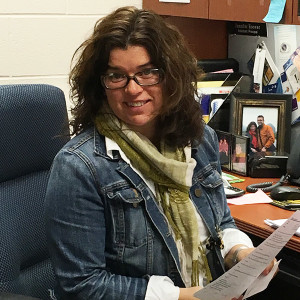 Jennifer Hoover of Richard Montgomery High School (RMHS), Montgomery County, Maryland, USA is her county’s magnet coordinator and her school’s Diploma Programme (DP) Coordinator (RMHS offers MYP years 4 and 5 plus the DP). She explains how Curriculum Connections helped the IB teaching team there meet programme and curriculum requirements.
Jennifer Hoover of Richard Montgomery High School (RMHS), Montgomery County, Maryland, USA is her county’s magnet coordinator and her school’s Diploma Programme (DP) Coordinator (RMHS offers MYP years 4 and 5 plus the DP). She explains how Curriculum Connections helped the IB teaching team there meet programme and curriculum requirements.
Q: Why did you choose Curriculum Connections for your staff?
JH: When the [IB] organization is looking at the needs of schools and is interested in trying new things, I am interested in being a part of that. It gives me a chance to get those opportunities sooner. As a result, I was excited … The other thing I liked was an opportunity that allowed us to work closely with the IB as well as with our teachers and give them something that was necessary.
Q2: How did know you needed Curriculum Connections?
JH: It was clear that we could use [this] service to support teachers struggling to balance the needs of county curriculum–what’s required of the schools—with teacher expectations. We have teachers who struggle to find the balance between the two. Having [an] expert who could build confidence in the teachers and help them navigate those needs was my interest. I also liked the idea that we were bringing someone [in] who wasn’t from our school district. Many teachers come back from training but [lack] momentum after the training: What do I do with what I’ve learned? How do I apply it? That sometimes gets lost in the day to day.
Q: How did your team work together within the context of the service?
We focused on the design team because we don’t have a department head. We called together that team and asked them ”Which curriculum would you like to have support with?” They chose Introduction to Engineering Design. We spoke with our consultant through an online forum; she asked probing questions about our needs and gave us a ‘to do’ list and a timeline. We provided her with our curriculum material. During the first three months of the service, [our consultant] took our material and with our objectives in mind came up with drafts and a proposal. Then we scheduled a meeting, using Skype. She shared models that showed alignment between county assessments and MYP assessments and rubrics that would meet the county needs and also would meet the objectives in our unit planners. She was able to help [us] see the pieces that were needed; the inquiry, the activities, the assignments that would then be final assessments for the units.
Q: When did your faculty become enabled to integrate the needed connections into their curriculum planning?
After the initial discussion, [our consultant] went back and reviewed the teachers’ materials, gave them suggestions and laid out ideas to help them see ways to apply [them]. We had hours of her time to use, and she was great, [asking], “What else can I help you do?” She was very responsive to the relationship.
We achieved our goal, which was to help make connections and solidify in [teachers’] minds how to keep going. They now know how to do this for the next unit. That is momentum.
Q: Would you recommend using Curriculum Connections to strengthen MYP teaching teams?
JH: It was very easy to see the benefits. Our teachers are benefiting from that one-on-one experience. We used [the service] for [one] subject area. I would see repeating the process on another department or with a department that doesn’t have strong leadership. Teachers in a high school tend to be departmentalized, so sometimes it’s harder to help them understand the connections in the MYP. If you have teachers who work independently, this service provides them with a foundation more easily monitored and supported by the coordinator.
Hear more from county magnet coordinator Jennifer Hoover about how Curriculum Connections helped her school’s MYP team meet their objectives.
How does this service differ from IB PD? MYP Coordinator Molly Clarkson explains.
